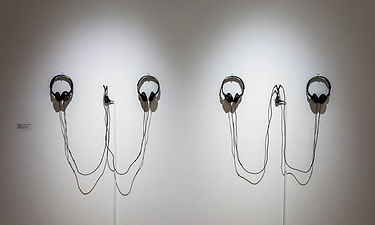.
Curaturial Programs
Revisiting In Visible Colours: An International Women of Colour and Third World Women Film/Video Festival and Symposium (1989)
Ana Valine and Roya Akbari
Women, Art, and the Periphery & Latin American Video Art in the VIVO Media Arts Centre Archives
Roya Akbari


.
Two Essays In Search of an Art Against Rape Culture 2016
Statement
This two-channel sound installation takes as a point of departure a conversation between Akbari and Granados on the relationship between art and rape culture. The two essays contained in the work are spoken in the voices of the artists. These voices carry the traces of their variously gendered and racialized bodies (female, Iranian, Guatemalan, queer) and draw on their shared language: the training in the visual. The work creates parallel meditations on the possibility of an art against rape culture. The artists quote and discuss a wide variety of art historical and contemporary works, as well as feminist and queer theory, in order to question visual culture’s complicity with and resistance to sexual violence. The artworks referenced range from the problematic to the liberatory, asking the listener to ponder images and ideas by Ana Mendieta, Rebecca Belmore, Gayatri Chakravorty Spivak, Ricky Varghese, Antonio da Correggio, and Paul Gauguin.

Dropping Off the Face of the Earth 2015
.
Curatorial Essay by Sarah Robayo Sheridan
Roya Akbari’s previous two short films Only Image Remains (2014) and Dancing Mania (2012) engaged the personal documentary form with specific attention to the context and production conditions of Iranian cinema. In Dancing Mania, she follows the making of her sister’s featureFrom Tehran to London (2012), threading together her own questions and interpretation of what is occurring within the film. The result is a parallel trajectory that explores the play of symbolic meanings invented in a cinema constrained by strict conditions of control. In Only Image Remains she takes as a point of departure her off-screen role in Abbas Kiarostami’s Ten, and proceeds from there to weave in interviews from prominent contemporary Iranian directors on the historical roots of cinema in Iran. In her thesis film, Dropping Off the Face of the Earth(2015), she shifts her attention to her own transnational life and subjectivity as an Iranian immigrant to Canada.
In a studio visit last year, she described being struck by the beauty of the landscape in British Columbia when she first arrived and feeling a sense of solace in the tranquility of the natural environment that was in deep contrast to the place she was leaving. As a young art student, this portrait quickly unraveled for her as she began to see, through artworks by Aboriginal artists such as Dana Claxton and Rebecca Belmore, that her new home was also underwritten by a trajectory of violence that had not been visible to her before. Thus through the medium of an essay film, Akbari attempts to grapple with the complexity of her forming relationship to Canada with this new knowledge in mind.



.
Only Image Remains 2014
A thirty-minutes experimental documentary film-essay, examines the history of pre-Revolutionary Iranian cinema through a series of interviews with prominent contemporary Iranian filmmakers in exile.
"Only Image Remains is a wistful search for home by a woman unable to exercise her creative impulses under the tyranny of her native land."
https://nextprojection.com/2015/03/04/iran-history-iranian-cinema-image-remains-review/


Dancing Mania 2012
.
The layers of my experiences shaped my aesthetics and politics, and I was self-conscious of not perpetuating orientalism and resisting commodification, fetishization, and cooptation of the stereotypical images of the eastern Other for the western gaze and audience. It was at that time that I found the necessity of using a hybrid form of visual, experimental, and documentary strategies to create Dancing Mania which incorporated feminist writing and the idea of embodiment and examines censorship and political repression of filmmaking and representation of women in Iranian film. I examined embodiment through the bodies of actresses, the body of a woman filmmaker who became exiled, and my own diasporic body that I situated through a voice-over. As a result of making this film, which was directly critical of the censorship of the theocratic regime, I was not able to go back to Iran and my body became exiled. The themes in Dancing Mania are still relevant today and the narratives of women’s struggle continue.
